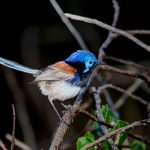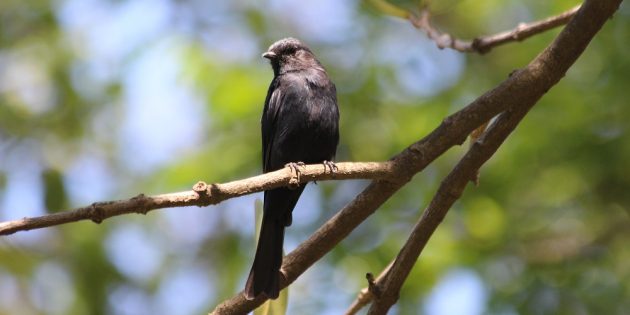
Birds – particularly long-distance migrants – need to store a substantial amount of energy. They store this energy as fat.
To be a bit more precise, they store energy mainly as triacylglycerols, which incidentally has exactly the same meaning as the word “triglycerides” but is a bit more formal and scientific.
Triacylglycerols are hydrophobic molecules in which three fatty acids are esterified to glycerol, resulting in a molecule like the one below.

On the left-hand side, one can see the glycerol part (up to the connecting -O- bridges). On the right-hand side, there are the fatty acids. These can vary. In the molecule shown above, the first one is a saturated fatty acid (i.e., no double bonds), the second one has one (cis) double bond, while the third one has multiple double bonds, making it a polyunsaturated fatty acid.
While the composition of these triacylglycerides can vary, those in migratory birds tend to have more unsaturated fatty acids. These unsaturated fatty acids have lower melting points and are easier to oxidize during long migration flights.
When in flight, hormones with names such as epinephrine and norepinephrine activate an enzyme, lipase. This enzyme catalyzes the hydrolysis of the triacylglycerides into the components, glycerol and the fatty acids.
These fatty acids are then bound by albumin, a polypeptide, in the blood and transported to the muscles. Inside the mitochondria of the muscle cells, the fatty acids are oxidized into water and carbon dioxide, with minimal byproducts. The energy set free via this oxidation is captured in adenosine triphosphate (ATP), a molecule that acts as a rechargeable energy storage that can be accessed by the muscles.
The water generated by the oxidation of the fatty acids (about 1 ml per gram of fat) is useful as well, particularly when flying long distances over oceans or deserts..
Oxidizing these triacylglycerides provides about 9 kcal/g of fat. This makes these molecules a very efficient energy storage medium – proteins and carbohydrates deliver less than half of this amount of energy per unit of weight.
In principle, humans and birds use the same energy storage via fat. But there are some differences in the chemistry involved:
- Birds almost exclusively use triacylglycerols for energy storage. Humans use this as well, but also depend on glycogen, a carbohydrate, for this, particularly during shorter periods of energy usage.
- So, birds are more fat-focused than humans. Their metabolism is optimized to oxidize fat at high rates, which can be sustained over long periods of time.
- The triacylglycerols utilized by birds have a higher content of unsaturated fatty acids. These are more reactive and thus more easily oxidized than saturated fatty acids.
- Birds – particularly migrating ones – have a higher capacity to store fat. Some double their body weight in a few days before migration.
- In the avian body, the fat is mainly stored under the skin, particularly in the wishbone region, along the belly, and under the skin. Humans also store fat more deeply, for example, around organs (ok, not chemistry, but worth mentioning).
Photo: Bar-tailed Godwit. According to BirdLife, this species holds the record for the largest non-stop flight of any bird, flying for 9 days and over 11,000 km without rest, eating or drinking. Powerful chemistry at work.












Leave a Comment